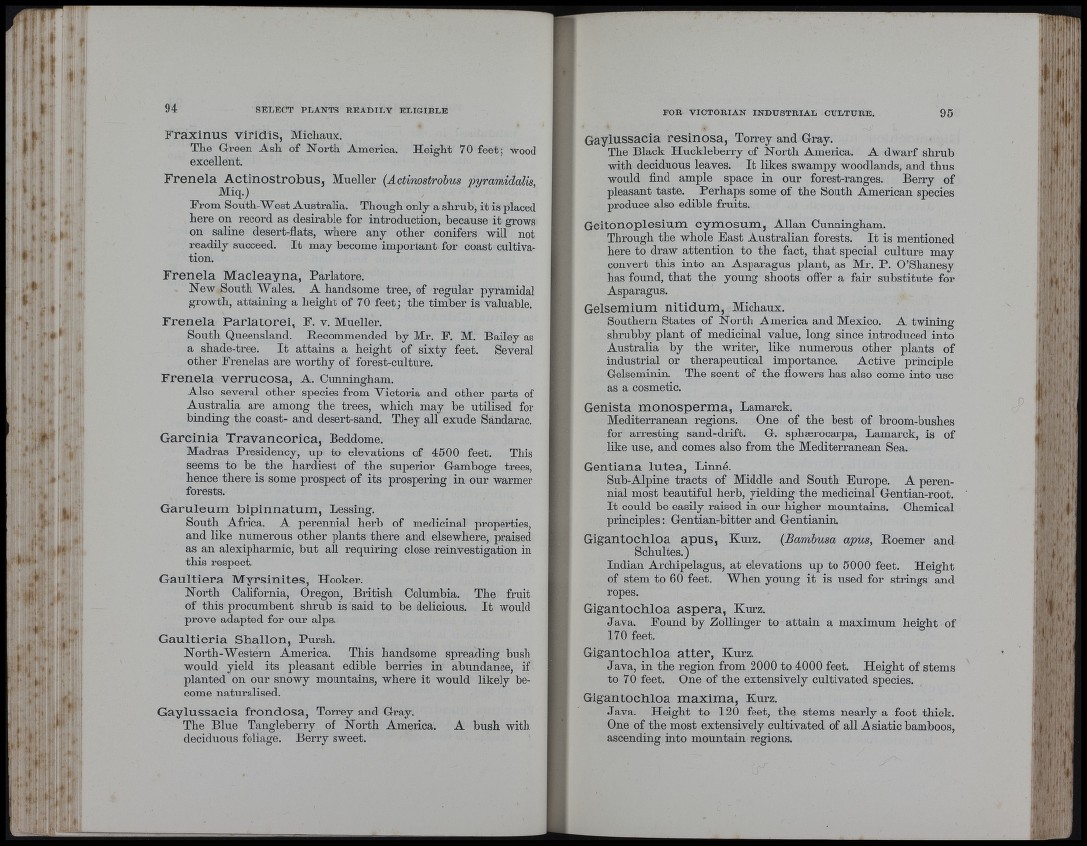
' Il
i
I '
Fraxinus viridis, Michaux.
The Green Ash of North America. Height 70 feet; wood
excellent.
Frenela Actinostrobus, Mueller (Actinostrobus pyramidoXis,
Miq.)
From South-West Australia. Though only a shrub, it is placed
here on record as desirable for introduction, because it grows
on saline desert-flats, wliere any other conifers will not
readily succeed. I t may become important for coast cultivation.
Frenela Macleayna, Parlatore.
New South Wales. A handsome tree, of regular pyramidal
growth, attaining a height of 70 feet; the timber is valuable.
Frenela Parlatorei, F. v. Mueller.
Soutli Queensland. Pecommended by Mr. F. M. Bailey as
a shade-tree. I t attains a height of sixty feet. Several
other Frénelas are worthy of forest-culture.
Frenela verrucosa, A. Cunningham.
Also several other species from Victoria and other parts of
Australia are among the trees, which may be utilised for
binding the coast- and desert-sand. They all exude Sandarac.
Garcinia Travancorica, Beddome.
Madras Presidency, up to elevations of 4500 feet. This
seems to be the hardiest of the superior Gamboge trees,
hence there is some prospect of its prospering in our warmer
forests.
Garuleum bipinnatum, Lessing.
South Africa. A perennial herb of medicmal properties,
and like numerous other plants there and elsewhere, praised
as an alexipharmic, but all requiring close reinvestigation in
tbis respect.
Gaultiera Myrsinites, Hooker.
North California, Oregon, British Columbia. The fruit
of this procumbent shrub is said to be delicious. I t would
prove adapted for our alps.
Gaultieria Shallon, Pursli.
North-Western America. This handsome spreading bush
would yield its pleasant edible berries in abundance, if
planted on our snowy mountains, where it would likely become
naturalised.
Gaylussacia frondosa, Torrey and Gray.
The Blue Tangleberry of North America,
deciduous foliage. Berry sweet.
A bush with.
G a y lu ssa c ia resin o s a , Torrey and Gray.
The Black Huckleberry of North America. A dwarf shrub
with deciduous leaves. I t likes swampy woodlands, and thus
would find ample space in our forest-ranges. Berry of
pleasant taste. Perhaps some of the South American species
produce also edible fruits.
G e ito n o p le s ium c y m o s u m , Allan Cunningham.
Through tbe whole East Australian forests. I t is mentioned
here to draw attention to the fact, th a t special culture may
convert this into an Asparagus plant, as Mr. P. O’Shanesy
has found, th a t the young shoots offer a fair substitute for
Asparagus.
G e ls em ium n i t id u m , Michaux.
Southern States of North America and Mexico. A twining
shrubby plant of medicinal value, long since introduced into
Australia by the writer, like numerous other plants of
industrial or therapeutical importance. Active principle
Gelseminin. The scent of the flowers has also come into use
as a cosmetic.
Genista monosperma, Lamarck.
Mediterranean regions. One of the best of broom-bushes
for arresting sand-drift. G. spbærocarpa, Lamarck, is of
like use, and comes also from tbe Mediterranean Sea.
Gentiana lutea, Linné.
Sub-Alpine tracts of Middle and South Europe. A perennial
most beautiful herb, yielding the medicinal Gentian-root.
I t could be easily raised in our higher mountains. Chemical
principles: Gentian-bitter and Gentianin.
Gigantochloa apus, Kurz. [Bambusa apus, Poemer and
Schultes.)
Indian Archipelagus, at elevations up to 5000 feet. Height
of stem to 60 feet. When young it is used for strings and
ropes.
Gigantochloa aspera, Kurz.
Java. Eomid by Zollinger to attain a maximmn height of
170 feet.
Gigantochloa atter, Kurz.
Java, in the region from 2000 to 4000 feet. Height of stems
to 70 feet. One of the extensively cultivated species.
Gigantochloa maxima, Kurz.
Java. Height to 120 feet, the stems nearly a foot thick.
One of the most extensively cultivated of all A siatic bamboos,
ascending into mountain regions.
I p ;
M
, ..i
'I
7;..,